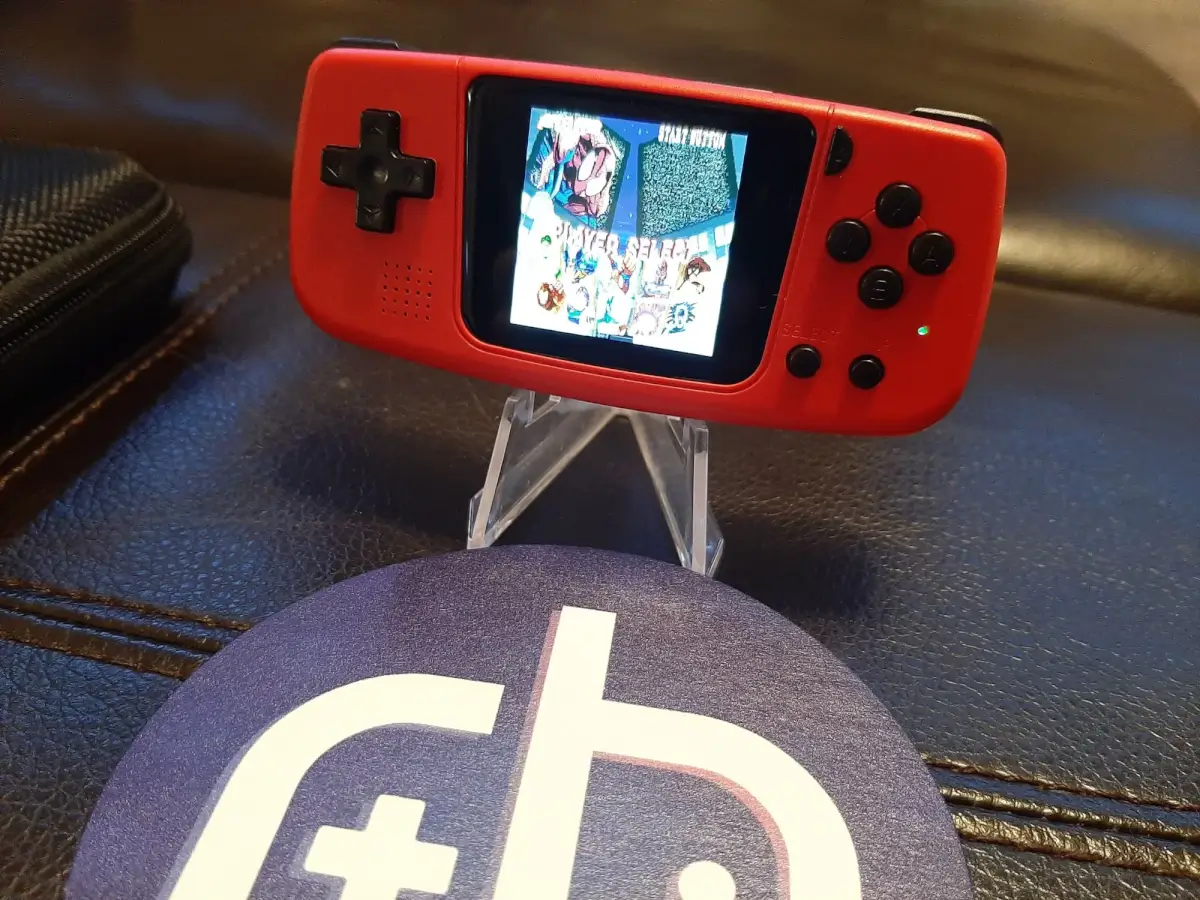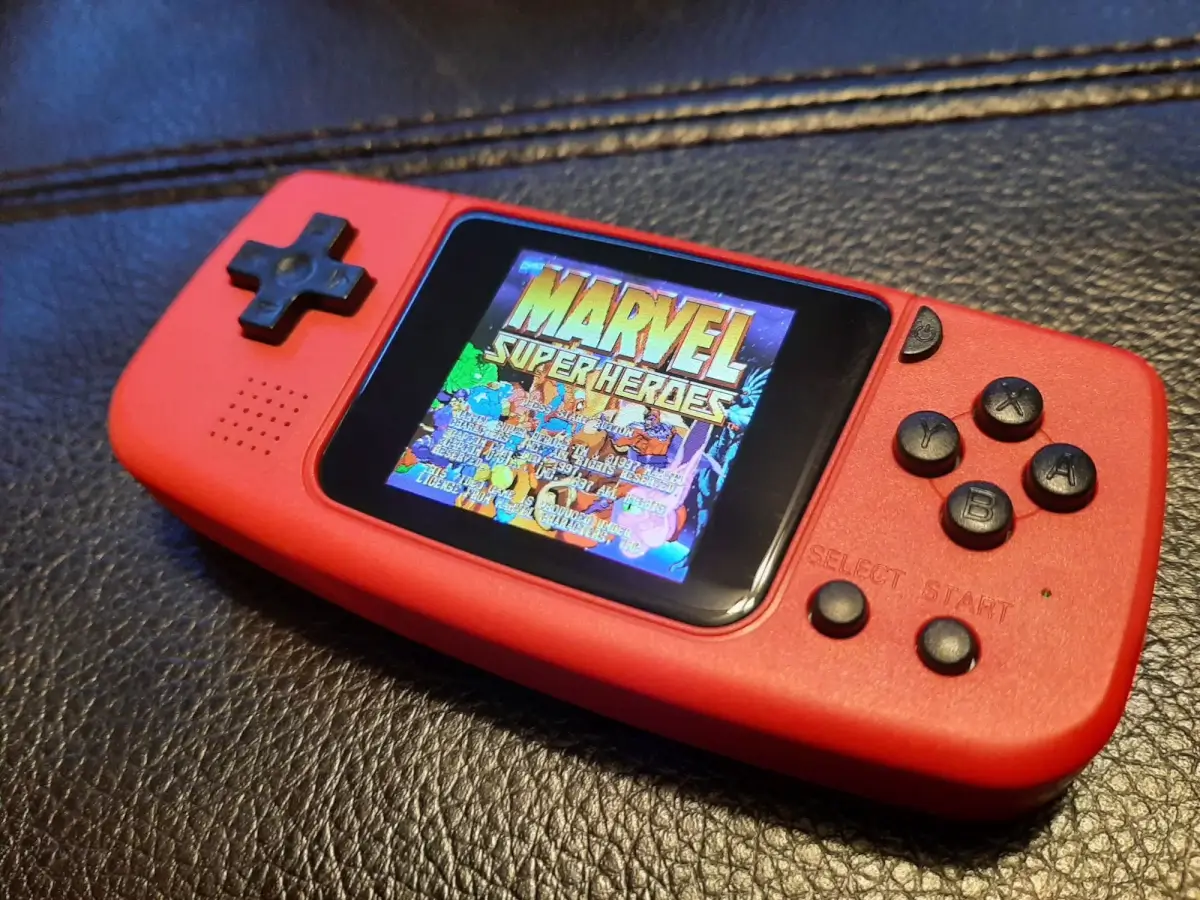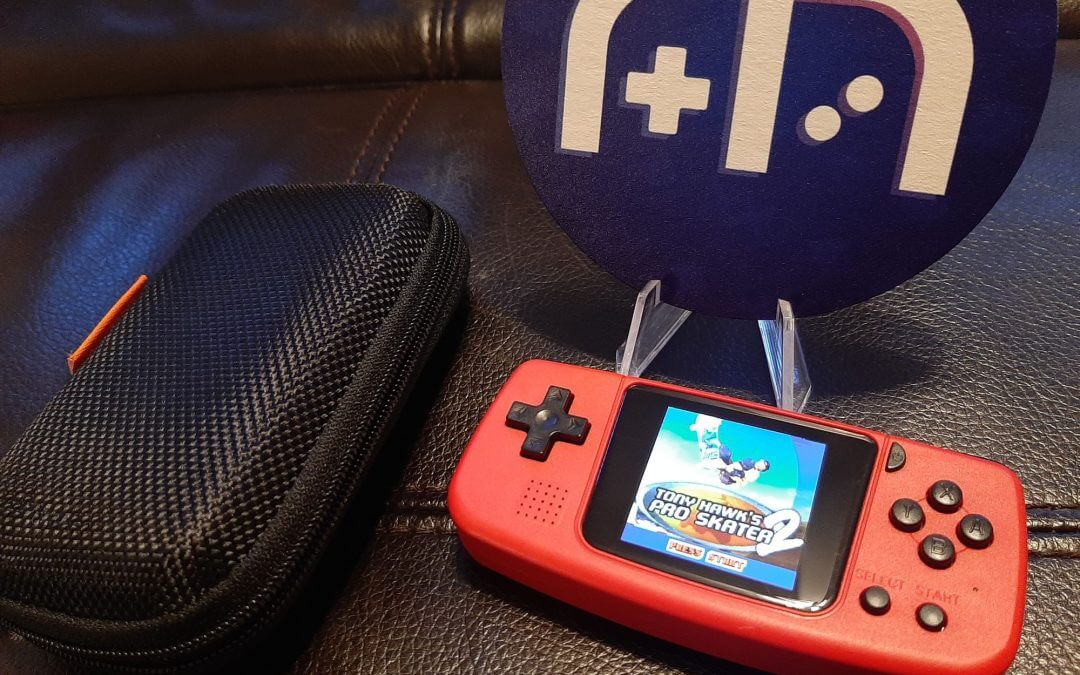(This review has been written and provided by Rocketman824)
Have you ever said to yourself “Self, when are you going to find a device so small it can fit in that little pocket in your jeans? You know the one above the right pocket that is great for like, Chap Stick?” Maybe you didn’t use that exact phrasing, but either way, you want that teeny-tiny handheld to keep on your keychain. Well there are a few of those out there. The FunKey S might be the most famous of the micro-handhelds, with its classic clamshell design and adorable aesthetic, but hey there are others that have made their mark in that particular size-range. One of them is the focus of today’s review, and you may have already guessed the name of it thanks to, well you know, the title of this write-up. It’s the Powkiddy Q36 Mini! It’s an adorable horizontal device with hints of GBA design and processing power that lifts it up over something like a Powkiddy V90; this thing is unique if nothing else.
Cuteness aside, I was curious as to what something of this size would actually be like to play games on. So, I charged the little guy up, threw some games on it, and gave it a shot. The results were…well they left me with feelings. As usual there were positives and negatives to the experience, and of course I will elaborate on each as I make my way through the review, but I will say right off the top…this thing is TINY. You can see it in pictures and videos, but still it’s tough to truly appreciate how small it is until you get it in your hands. Now that this one is in MY hands, I’m ready to talk about it.
Hardware
I’ll start this section off in the same place I left the last one; with the size. The Q36 Mini measures a measly 94mm long, 43mm tall, and 16mm thick. This puts it in rare company as far as gaming devices go, as few companies make things this small while including a screen. The plastic shell is sturdy but very light, which aids the device in being the overall lightest one I have ever personally used. It would absolutely be possible to have this in your pocket and altogether forget about it. Of course within the shell there lay buttons, ten of them to be exact. A dime-sized Dpad to the left of the small screen, four face buttons to the right, Start/Select below those and a Power/Menu button above. The final pair of buttons is a set of trigger buttons that sit atop the device on the edges, as is the usual practice. Aside from that the shell is pretty bare aside from the USB-C charging port and SD card slot in between the triggers. Speaker holes live near the southeast of the Dpad in a square pattern that mimics the screen itself. The only other assets are the four screw holes on the rear housing, and a small lanyard post on the bottom left corner. Yes indeed, you CAN put this sucker on a keychain!
The plastic itself is very slightly textured and feels nice. Coming in only red or yellow, the options are fairly limited as to the overall look of the handheld, but the colors look decent nonetheless. Red and yellow may be my least favorite colors, so I am somewhat disappointed by Powkiddy’s choice to only include these two choices for the q36 Mini, but I know some of you minimalists out there will enjoy them. The rounded edges of the plastic help keep it from digging into your skin (though it’s hardly large enough to do so…) and add to the comfort of holding the device, the comfort of actually playing is of course limited. For small gaming bursts, such as knocking out fifteen minutes of an old school RPG like Crystalis, it’s perfectly acceptable.
The Screen

Stop me if you’ve heard this before: 1.5 inches isn’t very big…and of course this pertains to the inch and a half sized square screen plastered on the front of the q36 Mini. If you have big thumbs, one of those could cover up most, or all, of the screen on this thing. Squinting might not even help some of the more visually impaired play games on it. Hell, BIFOCALS might not even he…I digress. However it isn’t all bad news. Despite some noticeable light-bleed on the sides, the screen is well lit and has a good array of brightness options: low leaves you with a screen that hardly looks backlit, while a high brightness shows up well even in light conditions. The bezels on the screen are an odd shape and are significant, which can be a huge turn off for people. They remind me a lot of the GBA screen and because of that I feel they are not a big distraction. Speaking of GBA, the games for that system look strange on the 240×240 screen because of its square shape, so in that situation, the screen is a bit of a letdown for sure. Menu text is crisp and clear thankfully, and that applies to most games and their text as well, though some certainly are harder to read than others. I suggest avoiding games with a ton of small text. My pervasive thought when it comes to the screen? It works for what it is, but it’s not an overwhelming joy to look at.
The Buttons
There are itty-bitty dark gray buttons on this device. We are talking little-tiny. Not only are they small but they are very close together (no doubt because of the lack of real-estate on the q36) making them less than ideal for playing things like Donkey Kong Country 2 which rely on the use of more than two of the face buttons. Platforming is TOUGH. My fat thumbs have a lot of trouble hitting only one face button at a time and it certainly causes issues with gameplay unfortunately. The Dpad is actually a bit better of a situation: it’s surprisingly usable. All four directions register well with little effort and minimal crossover. Inputs are responsive and the pad itself feels nice under the thumb. Moving over to the Start/Select buttons, I noticed that they are a fair distance from the rest of the face buttons, which is nice. Rarely did they get in the way, and when I needed to hit them it was easy. Not bad. Right next to the screen on the right side you’ll find the Power button, which also serves as the Menu button when the device is on. It’s an odd, half-moon shape but is in an out-of-the-way spot preventing accidental pushes. Heading to the top of the device we find the shoulder buttons (LR) and upon first press, it’s easy to notice the different, more clicky response compared to the other buttons on the device. The buttons are large enough to use somewhat easily which I found surprising on such a small handheld. Overall the buttons are actually pretty solid, they just might not be ideal for the platformer fans or those of us with some big ol’ thumbs…or even average adult sized thumbs honestly.

The Internals
Let’s get inside this thing, shall we? Here we find a Quanzhi V3S/ARM Corte-A7 CPU running at 1.2GHz, a 1000mAh battery, an SD card slot (up to 256gb cards compatible), and a 1 watt speaker. The CPU is able to handle games from generations up to the PlayStation, and it provides a fairly snappy and smooth experience when playing. Battery-wise, the low power requirements of the hardware help provide up to around 4 hours of battery life, depending on the systems played. It takes around an hour for the battery to charge from empty to full, making it a great choice for a quick grab-and-play device throughout the day without worrying about being attached to a charger. In fact the battery life made it easier for me to review, as it wasn’t always tethered to the wall and thus could live in my pocket. The speaker is…well it’s a speaker, so that’s something. The sound it produces is not what I’d call good, though it does get fairly loud. It’s to be expected from a small mono speaker, but still it is one of the letdowns of the device for me. Of course you always have the option to plug in your headpho…nope. The speaker provides the only sound you’ll get, unfortunately. Thankfully the SD card slot provides a way to load custom firmware and plenty of roms onto it with the ability to use up to 256 GB cards. I’d say a 64 GB or even 32 GB would be plenty even with a good chunk of PS games on there, but hey, options are options, and people go ape turds over options. (Ape turds?)
Software
Some of you may be familiar with another micro device floating around out in the retro-space by the name of the Funkey S. Well if you aren’t, all I will say is that it’s tiny and capable much like the q36 Mini, and that they run on the same firmware. The Funkey OS is a nice, clean Linux based system that runs very nicely on our little friend here. With changeable themes, a simple design, and easy to navigate menus, it lends itself well to a device meant to be a quick and easy gaming tool. It offers a solid amount of customizable options while not being overwhelming about them. Save states, brightness, volume (since you know, no buttons for it), and aspect ratio options are all available through an in-game menu. On the home screen of the OS you are greeted with an L and R scrollable UI featuring an emulator list, a settings menu, and an applications section (though it really only contains a file explorer). In the Settings portion you are able to change the theme, the wallpaper, the language/brightness level/screen timeout, along with a couple other options. You will also find an About icon that leads to information and credits. The meat of the OS is of course Emulators. That’s the place where you will spend the majority of your time. If you put your legally-collected rom files into the correct folders on the SD card, then finding them on the device itself will be simple. Clicking on a particular emulator will bring you right to the pre-determined directory storing that exact system’s games, making it a breezy cake…piece of breeze cake…easy to start gaming. Once in a game, pressing the Power button will act as a Menu button instead, bringing up the options I mentioned above. Save states are an obvious plus, and the ability to change the aspect ratio will come in handy, especially for GBA games. As a whole the Funkey S operating system is a great fit on the q36 Mini, and is a large part of why I enjoy the handheld. Keeping it simple goes a long way with me and on a small device such as this one, anything more complicated would just clog up the experience.

| Fully Playable |
|---|
| Atari 2600, Atari 5600, Atari 7800 |
| Nintendo Entertainment System |
| Super Nintendo Entertainment System |
| Nintendo Game Boy |
| Nintendo Game Boy Color |
| Nintendo Game Boy Advance |
| Nintendo Virtual Boy |
| Sega Master System |
| Sega Genesis / Mega Drive |
| Sega 32X |
| Sega CD |
| Neo Geo Pocket |
| Neo Geo Pocket Color |
| Mostly Playable |
| Sony Playstation |
| Not A Chance |
| Nintendo 64 |
| Nintendo DS |
| Sega Saturn |
| Sega Dreamcast |
Game Testing
You should have already gotten a hint of which games may run and look best on this device, but in case you hadn’t picked up on it, the answer is Gameboy games; Gameboy and Gameboy Color, to be exact. The two-button games lend themselves well to the small face buttons, and the square resolution of them also matches up with that of this particular Powkiddy. So as you can imagine, I enjoyed these games the most during testing. However when you jump up above GB, GBC, NES, Genesis, things become a bit less rosy. For example, the screen makes GBA games look poor and distorted, taking away from the beauty of such titles as Golden Sun while also changing the overall feel and timing of something like Kirby: Nightmare in Dreamland. Sure you can change the aspect ratio to ‘scaled’ in order to fix that, but then the image, and particularly text, become even tinier. The games themselves run fine, they just simply don’t look or feel 100% correct. At the top of the list of emulate-able systems sits the PlayStation, and remarkably this thing can handle them fairly well. Tony Hawk’s Pro Skater 3 ran perfectly and was somewhat satisfying to play, albeit pretty difficult. The game looks decent but certainly not amazing, and the sound comes through well. I did run into a few snags in my PS1 testing, namely NBA Live 2003 freezing up completely once it hit the start menu. I don’t consider this a deal-breaker for whether or not to get this console, but just be aware that PlayStation games will not be a great experience on the q36, much like SNES thanks to their use of the four face buttons.
Where to Buy
AliExpress
Amazon
Powkiddy Official
Average Price
$60-70
Delicious:
- Pocketable AF
- Horizontal aspect makes it more comfortable than a tiny vertical device
- Dpad is better than expected, making it overall more playable
- Great range of playable games for its size
- Absolutely ADORABLE
Suspicious:
- Being tiny causes playability issues with the buttons and viewing problems with the screen
- Speaker quality is lackluster
- No volume buttons is always a bummer to me
- Only two color options, neither of which get my juices flowing
Final Thoughts:
- What else is there to say about the Powkiddy q36 Mini? Size is its biggest strength and weakness! The handheld is miniscule, the screen a bit tough to see, and the speaker a bit less than stellar. But the smallness lends itself to perfect pocketability, overall cuteness, and a nice aspect ratio for GB/GBC games. The price is just on the fair side of overall cost, sitting at around $60-70, shipping included or not, and I feel like you do get a lot in return as far as performance goes. However, I would not use this device as a first or only handheld. It’s too small for comfortable long term use, and I fear if it were the first one you had ever bought, it may sour you toward the feeling of retro handhelds because of the lack of comfort. The q36 Mini is a bit of a novelty, something to show cool people at a party, or average people at a sporting event. It’s there to bedazzle your keychain and impress even the cutest nerd at the local movie theater. It doesn’t pretend to be a full-fledged every day-use kind of handheld. So please don’t treat it as such, and I’m sure you’ll enjoy its jovial company.
(This review has been written and provided by Rocketman824)
